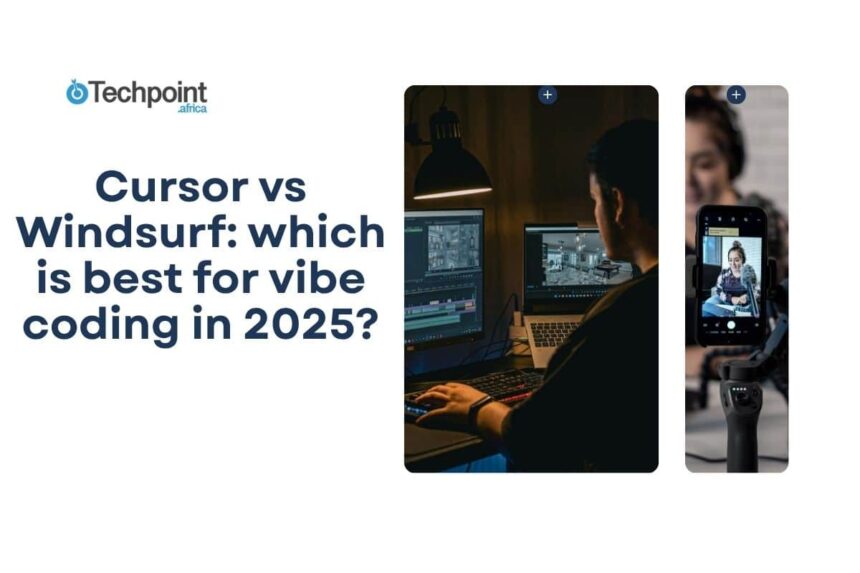First, let’s talk about setup and UI polish. When you open Cursor, you’re greeted with a familiar VS Code interface, but with some added features. The customization options are deep, allowing you to tailor the editor to your preferences. The AI agent features are seamlessly integrated, and the overall experience is smooth and intuitive.
On the other hand, Windsurf has a clean and modern UI that is easy to navigate. The Cascade agent is prominently displayed, and the layout is designed to minimize distractions. The UI is beginner-friendly and offers quick access to essential features. Overall, Windsurf has a more polished and visually appealing interface compared to Cursor.
Next, let’s discuss AI quality. Cursor’s AI capabilities are impressive, especially when it comes to code generation, pair programming, and debugging. The AI suggestions are accurate and helpful, and the tool excels at understanding project context. However, there are times when the AI can be a bit slow to respond, especially when working on larger projects.
On the other hand, Windsurf’s AI, powered by the Cascade Memory System, is top-notch. The tool excels at project-wide code intelligence, refactoring across files, and live UI previews. The AI suggestions are quick and accurate, and the tool does an excellent job of following your coding logic. Overall, Windsurf’s AI quality is superior to Cursor’s.
Now, let’s talk about flow-state ergonomics. Cursor is designed for deep focus, with features that support your flow like a quiet senior dev. The tool fades into the background, allowing you to concentrate on your code without distractions. Cursor’s layout is clean and minimal, and the tool excels at tasks like debugging, test writing, and local work.
On the other hand, Windsurf is built for creative velocity, with agent-driven AI and UI-first features. The tool shines when you’re scaffolding ideas fast or iterating on frontend-heavy projects. Windsurf’s layout is designed to maximize productivity and minimize friction, making it ideal for developers working on complex projects.
When it comes to performance and stability, both Cursor and Windsurf are solid choices. Cursor is known for its stability and reliability, with minimal bugs or crashes. Windsurf also performs well in terms of performance, with quick responses and smooth operation. However, Windsurf may require more review for bold multi-file edits, as the AI can sometimes make unexpected changes.
In conclusion, both Cursor and Windsurf are excellent AI coding tools that can help you code faster, focus longer, and ship better. If you value structure and control, Cursor may be the better choice for you. However, if you prefer speed and creative velocity, Windsurf might be the tool that suits your coding vibe. Ultimately, the choice between Cursor and Windsurf comes down to your coding style and preferences.
Overall, both tools offer unique features and benefits, and it’s worth giving them a try to see which one aligns best with your coding workflow. Whether you choose Cursor or Windsurf, incorporating AI coding tools into your development process can enhance your productivity and creativity, allowing you to achieve your coding goals more efficiently.
Its AI capabilities shine in understanding the context of the code and offering comprehensive solutions. Cursor, on the other hand, is more direct and to the point, but may lack the depth and thoroughness that Windsurf provides.
Final thoughts
Both Cursor and Windsurf offer unique experiences for developers looking for a new coding environment. Cursor excels in its simplicity and speed, making it a great choice for those who prefer a minimalist approach. On the other hand, Windsurf stands out with its vibrant interface and advanced AI capabilities, making it ideal for developers who enjoy a more interactive and visually stimulating coding experience.
Ultimately, the choice between Cursor and Windsurf comes down to personal preference and the specific needs of the developer. Whether you prioritize speed and efficiency or creativity and AI assistance, both tools have something to offer in the ever-evolving landscape of coding environments.
So, which tool will you choose for your next coding project? The calm focus of Cursor or the vibrant energy of Windsurf? The decision is yours to make, but rest assured that both tools have the potential to enhance your coding experience and help you achieve your development goals. Happy coding! It never crashed on me, and I never lost any work, even during intense debugging sessions.
Windsurf
Windsurf is more of a high-energy performer. It felt a bit heavier on resources, especially when running animations or syncing files in the background. I noticed some lag when switching between tabs in larger projects, and occasional hiccups when opening multiple terminals at once.
However, Windsurf did impress me with its stability during live collaboration sessions. Even with multiple users editing the same file simultaneously, it managed to keep up without any major issues.
Bug report
One bug I encountered was with Cursor’s code completion occasionally suggesting incorrect function names when working with React components. It was a minor annoyance but could cause confusion for newer developers.
On the other hand, Windsurf had a bug where the live collaboration feature would sometimes freeze if a user disconnected and reconnected too quickly. This issue disrupted the flow of pair programming sessions and required a refresh to resolve.
Final verdict
After thorough testing and comparison, it’s clear that both Cursor and Windsurf have their strengths and weaknesses. Cursor excels in prompt handling, refactoring quality, and error diagnosis while maintaining a helpful tone. Its clean interface and focus on deep contextual understanding make it ideal for developers who value efficiency and precision in their coding experience.
On the other hand, Windsurf shines in its visual appeal, live collaboration features, and flexibility in customization. It caters to developers who enjoy a more dynamic and creative workspace, with a focus on collaboration and aesthetic personalization.
In the end, the choice between Cursor and Windsurf comes down to personal preference and specific workflow requirements. Developers who prioritize clean and efficient coding practices may lean towards Cursor, while those who thrive in a visually stimulating and collaborative environment may prefer Windsurf. Ultimately, both editors offer unique strengths that cater to different styles of coding, ensuring that developers have options that suit their individual needs. Overall, Windsurf is a powerhouse for fast-paced projects and collaborative environments, but it could use some fine-tuning in the confidence and transparency departments.
Conclusion
Both Cursor and Windsurf are impressive tools that bring a new level of AI assistance to coding. Whether you’re a solo developer grinding away on a passion project or a team collaborating on a complex application, there’s a tool here for you.
Cursor excels in providing a seamless coding experience, perfect for deep work and solo sessions. Its intuitive AI suggestions and minimalist UI make it a great choice for those who value focus and consistency in their codebase.
On the other hand, Windsurf shines in dynamic environments where quick builds and real-time collaboration are key. Its vibrant UI, live previews, and project-wide awareness make it a top choice for frontend developers and teams working on creative, UI/UX-rich projects.
Ultimately, the choice between Cursor and Windsurf comes down to your coding style, project needs, and personal preferences. Both tools have their strengths and weaknesses, but one thing is certain – they both offer a glimpse into the future of coding with AI assistance.
So, whether you’re riding the waves with Windsurf or navigating the coding landscape with Cursor, rest assured that you won’t be left stranded in a sea of uncertainty. No more “Are you sure?” panic moments – just smooth sailing ahead.
Overall, Cursor and Windsurf are two powerful tools that are changing the way developers work. They offer a new level of efficiency, collaboration, and creativity that can benefit both beginners and seasoned professionals. By integrating these tools into your workflow, you can streamline your coding process, write cleaner code, and ultimately become a more effective developer.
While there may be some hesitation in using these tools for production-critical code, the benefits they offer in terms of speed, context, and flow are undeniable. As the landscape of coding continues to evolve, tools like Cursor and Windsurf will become essential for developers looking to stay ahead of the curve.
So, take a deep breath, dive in, and see how these AI-assisted tools can revolutionize your coding experience. Who knows, they may just become your new best coding companions.
Engaging with online content is a common practice in today’s digital age. Whether you are browsing through articles, watching videos, or interacting on social media platforms, it is important to be aware of the subjective nature of the information you come across. This is why it is crucial to conduct your research and consult professionals where necessary.
When engaging with content, it is essential to understand that the information provided may be influenced by the author’s personal opinions, biases, or perspectives. As a reader, it is important to critically analyze the content and consider multiple sources to form a well-rounded understanding of the topic at hand.
It is also important to acknowledge that the information provided in online content may not always be accurate or reliable. There is a possibility of misinformation, errors, or outdated information being presented, which could potentially lead to misunderstandings or confusion.
By acknowledging the subjective nature of online content, you are taking responsibility for your own information consumption and decision-making process. It is important to approach online content with a critical mindset, question the validity of the information presented, and seek out additional resources or expert opinions to verify the information.
In the event that you rely on online content for important decisions or actions, it is crucial to exercise caution and ensure that you are making informed choices. By engaging with content responsibly and being aware of its subjective nature, you can mitigate the risk of potential losses or damages that may arise from misinformation or inaccuracies.
In conclusion, engaging with online content comes with a certain level of responsibility and awareness. By conducting your research, consulting professionals when needed, and approaching content with a critical mindset, you can navigate the digital landscape more effectively and make informed decisions. Remember to always be cautious and diligent in your information consumption to protect yourself from any potential risks. the world of fashion that highlights the latest trends in sustainable fashion.
In recent years, the fashion industry has been under scrutiny for its environmental impact. From the use of harmful chemicals in production to the excessive waste generated by fast fashion, consumers are becoming more conscious of the choices they make when it comes to their wardrobe. As a result, the demand for sustainable fashion has been on the rise, leading to a shift in the industry towards more eco-friendly and ethical practices.
One of the latest trends in sustainable fashion is the rise of eco-friendly materials. Designers are increasingly turning to fabrics that have a lower environmental footprint, such as organic cotton, hemp, and bamboo. These materials are not only better for the planet but also offer a more luxurious and high-quality feel to the garments they create. Additionally, recycled materials, such as plastic bottles and old denim, are being used to create stylish and innovative pieces that are both fashionable and eco-conscious.
Another trend in sustainable fashion is the concept of slow fashion. This movement encourages consumers to buy fewer, higher-quality pieces that are made to last, rather than constantly purchasing cheap, disposable items. By investing in timeless wardrobe staples that are well-made and durable, consumers can reduce their overall carbon footprint and contribute to a more sustainable fashion industry.
In addition to materials and production methods, designers are also focusing on ethical practices in their supply chains. Many brands are now working with Fair Trade-certified factories and artisans to ensure that workers are paid fair wages and work in safe conditions. By supporting ethical fashion brands, consumers can feel good about the clothes they wear, knowing that they are contributing to a more just and sustainable industry.
Overall, the latest trends in sustainable fashion are not only stylish and innovative but also have a positive impact on the planet and the people who make our clothes. By embracing eco-friendly materials, supporting slow fashion, and choosing ethical brands, consumers can play a role in shaping a more sustainable and responsible fashion industry. As the demand for sustainable fashion continues to grow, it is clear that this is not just a passing trend, but a movement towards a more conscious and ethical approach to style. The global pandemic has brought about many changes in our daily lives, including the way we work, socialize, and travel. One of the industries that has been heavily impacted by the pandemic is the travel industry. With travel restrictions in place and borders closed, many people have had to cancel or postpone their travel plans.
As countries around the world continue to navigate the challenges brought about by the pandemic, the travel industry is slowly starting to recover. With the rollout of vaccines and the easing of travel restrictions in some places, many people are starting to plan their long-awaited vacations once again.
However, the travel industry is not expected to bounce back to pre-pandemic levels overnight. Travelers are now more cautious and are looking for ways to stay safe while traveling. This has led to a shift in travel trends, with more people opting for domestic travel and outdoor destinations where they can easily practice social distancing.
In response to these changing trends, many travel companies are adapting to meet the needs of their customers. Airlines are implementing new safety measures, such as enhanced cleaning protocols and mandatory mask-wearing, to ensure the safety of passengers. Hotels and resorts are also taking steps to provide a safe and hygienic environment for guests, with increased cleaning and sanitation practices in place.
Travelers are also becoming more conscious of the impact of their travel on the environment. Sustainable travel practices, such as reducing plastic waste and supporting local communities, are becoming increasingly popular among travelers. Many hotels and tour operators are now offering eco-friendly options for travelers who want to minimize their carbon footprint.
As the travel industry continues to evolve in response to the pandemic, it is clear that the way we travel will never be the same. While the industry may have faced challenges in the past year, it has also shown resilience and adaptability in the face of adversity. With the rollout of vaccines and the gradual reopening of borders, the future of travel is looking brighter, and travelers can once again look forward to exploring new destinations and creating unforgettable memories. The Importance of Mental Health in Today’s Society
In recent years, mental health has become a significant topic of discussion in society. With the rise of mental health awareness campaigns, advocacy groups, and increased media coverage, the importance of mental health is finally being recognized and prioritized. It is no longer a taboo subject, but rather a crucial aspect of overall well-being that cannot be ignored.
The World Health Organization defines mental health as a state of well-being in which an individual realizes their own abilities, can cope with the normal stresses of life, can work productively, and is able to contribute to their community. This definition highlights the interconnectedness of mental health with physical health, social relationships, and the ability to function effectively in daily life.
One of the reasons why mental health is so important in today’s society is because of the prevalence of mental health disorders. According to the National Institute of Mental Health, approximately 1 in 5 adults in the United States experience a mental illness in a given year. This statistic highlights the fact that mental health issues are not rare occurrences, but rather common experiences that many individuals face.
Furthermore, mental health has a significant impact on physical health. Studies have shown that individuals with mental health disorders are at a higher risk for developing chronic physical conditions such as heart disease, diabetes, and obesity. This is due to the fact that mental health disorders can affect behaviors such as diet, exercise, and sleep, which in turn can impact physical health outcomes.
In addition, mental health plays a crucial role in social relationships and overall well-being. Individuals with good mental health are more likely to have strong social support networks, healthy relationships, and a positive outlook on life. On the other hand, individuals with poor mental health may struggle to maintain relationships, experience social isolation, and have a negative self-image.
Given the importance of mental health in today’s society, it is essential that we prioritize mental health and well-being in our daily lives. This can be done through self-care practices such as exercise, mindfulness, and stress management techniques. It is also important to seek professional help if needed, whether it be through therapy, counseling, or medication.
Ultimately, mental health is a crucial aspect of overall well-being that cannot be ignored. By recognizing the importance of mental health and taking proactive steps to prioritize it, we can improve our quality of life, strengthen our relationships, and contribute positively to our communities. Let us continue to raise awareness, reduce stigma, and advocate for mental health in today’s society.








